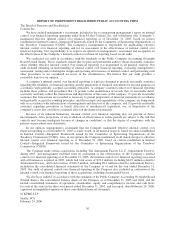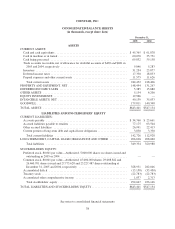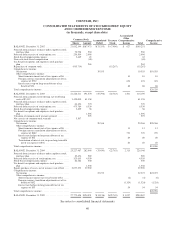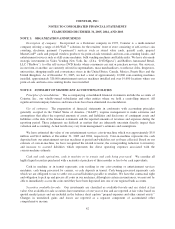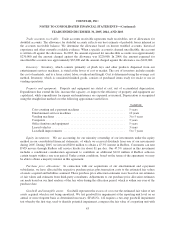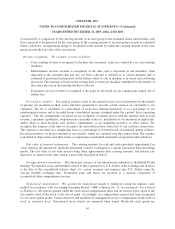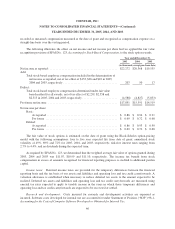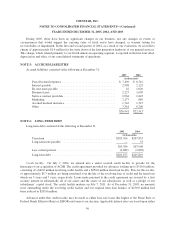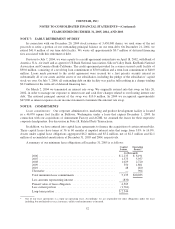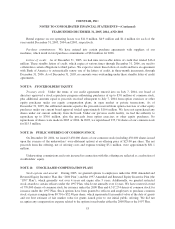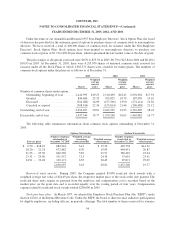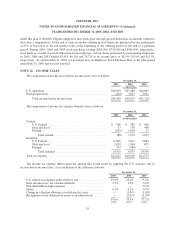Redbox 2005 Annual Report Download - page 49
Download and view the complete annual report
Please find page 49 of the 2005 Redbox annual report below. You can navigate through the pages in the report by either clicking on the pages listed below, or by using the keyword search tool below to find specific information within the annual report.COINSTAR, INC.
NOTES TO CONSOLIDATED FINANCIAL STATEMENTS—(Continued)
YEARS ENDED DECEMBER 31, 2005, 2004, AND 2003
is measured by a comparison of the carrying amount of an asset group to the estimated undiscounted future cash
flows expected to be generated by the asset group. If the carrying amount of an asset group exceeds its estimated
future cash flows, an impairment charge is recognized in the amount by which the carrying amount of the asset
group exceeds the fair value of the asset group.
Revenue recognition: We recognize revenue as follows:
• Coin counting revenue is recognized at the time the consumers’ coins are counted by our coin-counting
machines;
• Entertainment services revenue is recognized at the time cash is deposited in our machines. Cash
deposited in the machines that has not yet been collected is referred to as coin-in-machine and is
estimated at period end and reported on the balance sheet as cash in machine or in transit and cash being
processed. This estimate is based on the average daily revenue per machine, multiplied by the number of
days since the coin in the machine has been collected;
• E-payment services revenue is recognized at the point of sale based on our commissions earned, net of
retailer fees.
Fees paid to retailers: Fees paid to retailers relate to the amount we pay our retail partners for the benefit
of placing our machines in their stores and their agreement to provide certain services on our behalf to our
customers. The fee is calculated as a percentage of each coin-counting transaction or as a percentage of our
entertainment revenue and is recorded in our consolidated income statement under the caption “direct operating
expenses.” The fee arrangements are based on our evaluation of certain factors with the retailers such as total
revenue, e-payment capabilities, long-term non-cancelable contracts, installation of our machines in high traffic
and/or urban or rural locations, new product commitments, co-op marketing incentive, or other criteria. We
recognize this expense at the time we recognize the associated revenue from each of our customer transactions.
This expense is recorded on a straight-line basis as a percentage of revenue based on estimated annual volumes.
In certain instances, we prepay amounts to our retailers, which are expensed over the contract term. The expense
is included in depreciation and other in the accompanying consolidated statements of operations and cash flows.
Fair value of financial instruments: The carrying amounts for cash and cash equivalents approximate fair
value, which is the amount for which the instrument could be exchanged in a current transaction between willing
parties. The fair value of our term and revolving loans, approximates their carrying amounts. Our interest rate
derivative is carried at fair value, which is more fully described in Note 6.
Foreign currency translation: The functional currency of our International subsidiary is the British Pound
Sterling. We translate assets and liabilities related to these operations to U.S. dollars at the exchange rate in effect
at the date of the consolidated balance sheet; we convert revenues and expenses into U.S. dollars using the
average monthly exchange rates. Translation gains and losses are reported as a separate component of
accumulated other comprehensive income.
Stock-based compensation: We account for stock-based awards to employees using the intrinsic value
method in accordance with Accounting Principles Board (“APB”) Opinion No. 25, Accounting for Stock Issued
to Employees. All options granted under the stock-based compensation plans had an exercise price equal to the
fair market value of the stock at the date of grant. Accordingly, no compensation expense has been recognized
for our stock option grants. Certain directors and members of management receive compensation in the form of
stock or restricted stock. Unrestricted stock awards are expensed when issued. Restricted stock grants are
45



